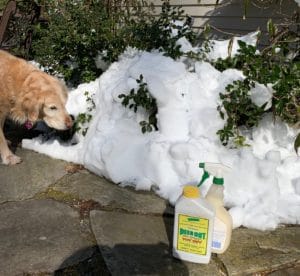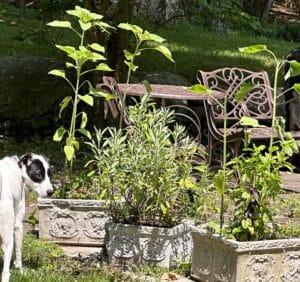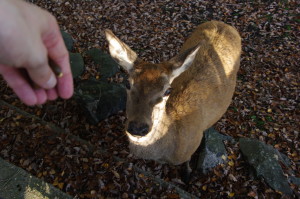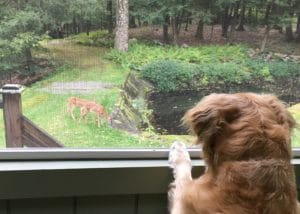Hello fellow readers,
I woke this morning to my adored sunflowers grown from seed in the garden pots chomped by Bambi, as were the ‘Palace Purple’ Heuchera (Coral Bells). Unlike years past, I didn’t lose my cool – a good thing in the recent heat wave.
“No point in crying over spilled milk,” one of Mom’s many idioms often shared. I never liked milk anyway.
Old-time idioms help the hurt.
While mixing my preferred natural deer spray, another saying came to mind bringing a smile. “The horse is out of the barn,” meaning it’s too late to fix what already happened. The saying stems from the days when horses pulled carriages and stagecoaches. After the horse left the barn and began its trip, it was too late to get on it. Comparable to “the train has already left the station.” Idioms are fun and help the hurt of deer dilemmas.

One year the top branches of these Blue Holly peeking out of the snow were heavily browsed.

Jolee posing beside the browsed sunflowers (on the right)
But it’s not too late to prevent more damage. The thing is, I sprayed the plants a few weeks ago, but that was before the heavy rains. Deer-Out is one of my go-to’s. The main active ingredient is peppermint oil mixed with garlic oil, white pepper, and putrescent whole eggs. Putrescent means rotting, but at least Deer-Out doesn’t smell like a bad septic on a hot day.
Non-stinky Deer Deterrents
Deer Stopper is another spray with natural and systemic ingredients that won’t wash off in the rain for three months under normal conditions. However, they suggest spraying every month and more often during rapid growth. That was my weak link. And it’s best to rotate sprays so deer don’t grow accustomed; I learned the hard way.

I heard from a neighbor about a doe who hovers close by, and she talks to her. She is beautiful. But taming wildlife adds to the dilemma.

Don’t feed deer, dear.
Feeding Deer is Detrimental
Deer are hardwired to get through the winter on their own. In the Fall, they go into a feeding frenzy to build a fat reserve to accompany their winter coat, so pump up the deer spray come Fall.
It’s tough not to feel bad for wildlife, especially when temperatures are frigid, and snow abounds. But feeding deer and other wildlife can harm them, as you’re drawing more deer into an area. Deer corn is like junk food that can disrupt the gut microbiomes necessary to digest their regular diet, causing painful stomach problems, severe diarrhea, and dehydration, which can be deadly.
With the increase in the deer populations in a concentrated area, there is more danger of spreading parasites and diseases such as Chronic Wasting Disease, similar to Mad Cow Disease. But unlike Mad Cow, no confirmed cases of humans contracting it exist.
The Centers for Disease Control and Prevention (CDC) site states, “As of March 2023, there were 405 counties in 29 states with reported CWD in free-ranging cervids (deer).”

Plus, feeding deer (and bear by leaving trash outside) can dramatically increase their fertility, which adds to the problem of overpopulation. Like feeding bears, by feeding deer, they lose their fear of humans and can become dangerous.
As the cold weather sets in, their metabolism slow, they become less active, and seek sheltered areas. Supplementing food interrupts its natural ability to adapt and survive. So no help is the best help for deer (and your garden).
Garden Dilemmas? AskMaryStone@gmail.com and your favorite Podcast App.
There’s more to the story in the Garden Dilemmas Podcast:
More Deer Tips and Twists:
Another remedy is choosing deer-resistant plants. Check with your local extension office. Rutgers University here in New Jersey has a deer-resistant list that is searchable by category of plant material and by degree of resistance from rarely to frequently damaged.
While an excellent resource, I find what deer eat varies by neighborhood. Do deer pow wow amongst each other, “Hey, have you tried Echinacea?” Well, my deer have. While categorized as seldom severely damaged on the Rutgers list, I’ve had to deer spray the heck out of my Echinacea.
Products with coyote urine, pig’s blood, egg solids, edible animal proteins, hot pepper concentrate, and ammonium soaps run the gambit. One manufacturer touts their product’s smell and taste deterrents like this: “It mimics the scent of a dead animal triggering a flight response in deer.” — a dead animal smell right outside your door? Deer won’t be the only ones repelled! I think I’ll stick with my go-to.
More about why Feeding Deer Promotes Disease
Centers for Disease Control and Prevention (CDC) report of Occurrence of Chronic Wasting Disease.


